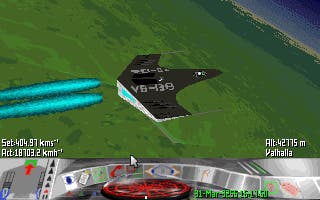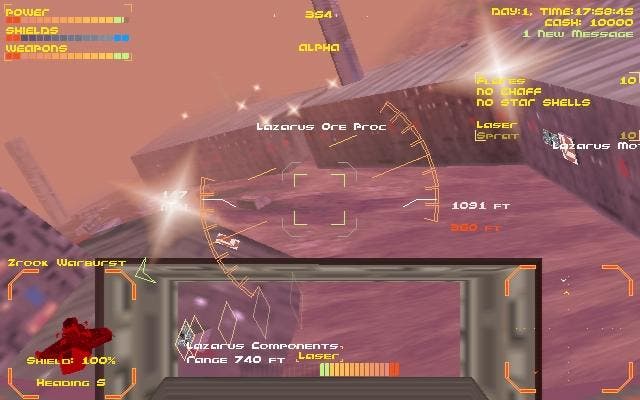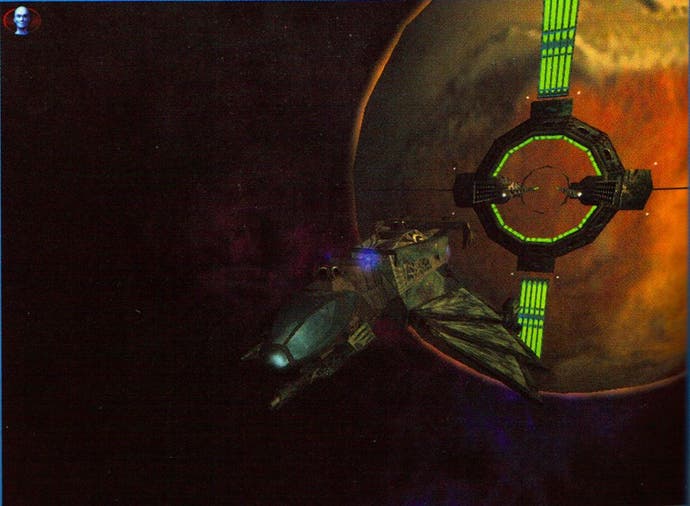The Final Frontier?
Where are space simulations going in the future? Mat Bettinson says, "To understand the future - we must look to the past" .. or something.
The Final Frontier? Ask any amateur pop psychologist, and they will tell you the appeal behind computer games is escapism.
Take John Martin, our fictional overweight 30-something IT manager in a city firm. He does all right for himself, does our John, his wife and kids not left wanting for basic necessities.
However John, like most of us, needs something a bit extra in his life. The thing is, John's sense of scale mimics his waistline. So what does John Martin dream of when he retires to his PC?
Fleeing from reality into our lush PC gaming environment, we have a choice of genres to get stuck into. Whether you fancy yourself as a bit of a gun-toting hero (John Willis) or a champion race driver (John Schumaker), virtually all glamorous pastimes on Earth are simulated, rendered and lavishing slapped in an oversized shrink-wrapped box on your local HMV software shelf.
Complete with reassuring lies about the system requirements.
Mundane Simulations
Some of us look beyond these mundane simulations though. What is the point of a computer game if it is just a poor shadow of the real thing, available right here on Earth?
For some of us a poor shadow of a glorious star-faring future is infinitely more alluring than a year's worth of chart topping Lara clones. Step up to the limelight Captain John Martin, commander-in-chief of the NTF Battlecruiser Colossus.
This is the ultimate escapism, imagination so powerful it boosts us out of Earth's deep gravity well and propels us into space.
Of course computer games didn't invent it - the sci-fi genre has been with us since the early 20th century. You know, when black and white damsels were carried off (silently) screaming by evil gorillas with boxes on their heads, complete with egg-whisk antennae. Hey, don't knock it - the matinee had a pianist.
Being technology based, it seemed logical that sci-fi was a genre taken up with aplomb by the early games programmers. Of course back then one programmer could do the code, music, and even graphics all by themselves.
Which was fine, since your imagination had to make the connection between a group of 14 low-resolution pixels and the Nebuchadnezzar, Mankind's Ultimate Fighter and Earth's Last Best Hope For Survival Against The Invading Tomatoes. Woohoo!

And Then Came Elite
Then came Elite. The mention of this name either results in misty eyes or glazed eyes depending on the age of the gamer. Suffice to say I fall into the former category. Wire rendered ships drawn out of a few lines, yes, but they were 3D baby!
The biggest technological breakthrough for Elite was not the graphics though, but the memory saving algorithms that provided galaxies full of systems, each with plausible sounding names - clearly a marvel given the 48K memory of the original BBC Micro!
Elite was also an important game because it pioneered a game style so unlike anything conceived of before, and still very unlike most games today. Until this point, a simple set of tasks was placed before the player and they got progressively harder. You replayed to get a better score, or perhaps further along.
Elite didn't have a point like this, its scale - like John's wasteline - was much bigger than that. Elite set out to simulate a lone pilot in a spacecraft, free to roam as they see fit.
Of course there was structure in the game in the form of an economy, we had to make money to upgrade our ship! Then there were the Thargoids who liked to jump the player in hyperspace and generally get up to no good. Of course Military Lasers would see those pesky varmits off.
In Elite we had a 3D game that simulated an economy, hundreds and hundreds of uniquely named systems, an upgradable ship, space dogfighting, and even mini-missions doled out from space stations. This was epic stuff, escapism on a cosmic level.
So what has happened since?

Dragged Back Into Linear Gameplay
Firstly, I'm not going to play into that school of thought that bitches that Elite was never outdone. That's not really the case, it's just that as PC technology moved on and game publishers perceptions on what the buying public valued moved on, the general thrust of space games was never so well rounded.
In general, with the advent of full motion video spooling off CD-ROM, space-sims were dragged back into the linear gameplay fold from whence they have not returned (with the exception of "X: Beyond the Frontier", which is largely an Elite clone anyway).
As PC specifications ballooned into the whiz-bang 3D extravaganza of the late 90s, the focus of space games became clear. It was John Cruise, the Top Gun ace fighter pilot that space games provided now.
After all, in this sort of game we could introduce each "mission" with some nice rendered video footage, and then we could get down to some serious space battles with lasers, missiles and loads of force feedback joystick waggling action. In effect, space-sims became flight-sims with lasers.
None of this will be new to you, dear reader. However I wonder if you've ever noticed the parallels between modern computer games and the sci-fi television and movies that formed the creative backdrop for these games?
In the early days, say around the "Doctor Who" and "Blake's 7" era (all together now "Ahhh!"), there weren't a lot of special effects on offer.
Yet in the present day, say episodes of "Babylon 5" and "Star Trek: Voyager", we would be disappointed if there weren't a few spooky subspace effects, wickedly rendered Shadow cutting beams weapons, and the odd photon torpedo salvo.
It was time for imagination to get down to the nitty gritty of space combat and the epic scales of violence, not to mention 3D accelerated eye-candy!
After all, who's to say that that lovely tri-linear filtered quad alpha textured technicolour explosion isn't what a Meson bomb looks like? Hey, it beats the good old 14 pixel Nebuchadnezzar right?
It's not particularly new ("Star Wars") but it looks damn believable, more believable than scooting around from planet to planet trading and site seeing without a goal.

The X:BTF Love/Hate Camp
Sadly modern space-sims have focused so much on a linear cinematically directed plot-line that there has been little room for the sort of scope and innovation that we saw way back in Elite.
Indeed German Developers EgoSoft thought so, because they essentially recreated Elite verbatim, albeit with some up-to-date whiz-bang graphics. The result was interesting, and spawned a polarized love/hate group.
Even here at EuroGamer opinions were divided [see our review from a few weeks back]. Ultimately though, "X: Beyond the Frontier" failed to take the genre where it needed to go beyond Elite, despite the grandiose title.
In contrast, around the same time "Freespace 2" was released. Once again this was firmly in the flight-sim with lasers category. The implementation was quite good, with some excellent graphics and varied missions. However, once again it was a mission based linear story that once finished (within a week for us) retired to the dust covered software library.
Freespace 2, while it lasted, did bring a scale and scope to epic space warfare only glimpsed at previously. Swarms of fighters dogfighting around massive capital ships that take minutes to fly over from end to end.
Space battle has arrived, but does that mean the death of the space trading sim in the face of one last big multicoloured explosion? One would hope not. It is this author's fervent wish that the two might blend, so that the rich background of the space trading game can provide the massive gameplay hours.
Yet there should be considerable effort to bring the moderm flight-sim with lasers into the fold to spice up space battle. Imagine that one of those big Freespace capital ships was not a Rakshasa class Shiva destroyer, but the local trading station.
I've been caught before waxing on about the possibilities in this genre, but suffice to say I believe the time is right for the space opera and the flight-sim with lasers to blend.
It's not all pie-in-the-sky - there is a lesser-known, extremely good space-sim already, in the form of Gremlin's poorly marketed Hardwar.
Hardwar looks stunning and chooses to set the game on a moon of Jupiter for visual impact, and also the prime "goal" is to leave Titan when you have got the ability.
Trading elements are built into the game extremely well, and it is one of the best bashes at the Elite idea without being a rip-off. Marketing was dismal though, as it was hyped well before coming out and was then forgotten about when finished.

Microsoft To The Rescue?!
And of course there is Microsoft's eagerly awaited Starlancer. Mind you, Starlancer looks to be in the flight-sim with lasers mould, but with the unique twist that the player will be able to move around inside their own ship and talk to their crewmates.
It is mission based, but they aren't linear, which is something at least. Hopefully it will bring enough new material to the party to provide the depth of gameplay missing from past efforts.
The big daddy however is Freelancer. Due at the end of next year, this is the next big title the disgruntled Elite advocates are pinning their hopes on.
The key element to the Digital Anvil developed masterpiece is the Free in Freelancer. Microsoft insist that the player is free to make their fortune however they like, which certainly sounds Elite.
However Freelancer is going to have good attention paid to the economy model (more than 20 commodities), and political and policing forces are to be simulated as well.
Then there are all the sub missions dynamically rolled out due to market forces, beautifully illustrated with some cutting edge graphics such as facial animations and truly obscene polygon counts for the spacecraft. Remember that this is due around the end of next year kids.
On the multiplayer front, things are a tad less rosy. There is so far no plan (known to us) underway to develop an Elite based massively multiplayer game, nor it appears any sci-fi persistent universe game at all. Something I believe is virtually a crime as we drown under more fantasy based offerings.
John Thistlewood : "Forsooth, hark at mine bow!", or Captain Jonny Starbuck : "Eat laser scum!"? No brainer if you ask me.
Instead, multiplayer seems to mean deathmatch dogfighting to developers so far, and that's your lot. Woe for the neglected space-sim genre.
Even the advanced flightsim multiplayer scenarios are yet to be duplicated, such as conducting a cooperative mission against an enemy space installation / planet or some such.
It seems that unless you are willing to shackle back down to earth, it is dogfighting only in outer space. In fact, this seems so popular there is even the cross-platform free Parsec project looking quite tasty.

Freelancer, A Year Too Long
But wait, Freelancer comes to the rescue again! In the most eye watering revelation, Digital Anvil promise that Freelancer will deliver the massively multiplayer sci-fi universe we have all been waiting for.
And sadly it looks like we are going to have to wait another year for it too... Freelancer is aiming for 1000 players per server, playing in a real-time universe with the same character interaction that one sees in a fantasy based game such as Everquest.
Only this time the first thing you will see will be a communication or a space ship rather than a jiggling tunic, and believe me you don't want to see John Martin in a tunic. In space, no-one can see you're fat.
Freelancer will tackle player killers and so on by having a system based upon inner worlds and so-called "frontier" worlds.
The former are quite sedate and well policed so players can merrily get on with their trading and socialising without fear of any horrid beastliness such as a 500 megawatt plasma beam through their hull. Space Trader John Morris might hang out around the inner worlds contented with his lot in life.
On the other hand, the frontier worlds are far more risky. Law is thin on the ground and the place seethes with players and NPCs out for generally no good. That means there is more than a slight chance of a frank exchange of views with some other unsavoury elements, generally resulting in explosive decompression - which is never pleasant. John Hook, the feared, reviled and quite badly smelling space pirate might lurk around these worlds.
As the icing on the cake, multiplayer Freelancer players and groups of players can manage bases, and those will become strategic points on the server. One can either seek to take over with money, or one can resort to good old-fashioned violence .. we like a bit of that!
It is a year away though, but hopefully Starlancer and the few obligatory flightsims with lasers will tide us over until then.
After all, it is 10 years since Elite, what's another year to wait?





.png?width=291&height=164&fit=crop&quality=80&format=jpg&auto=webp)

